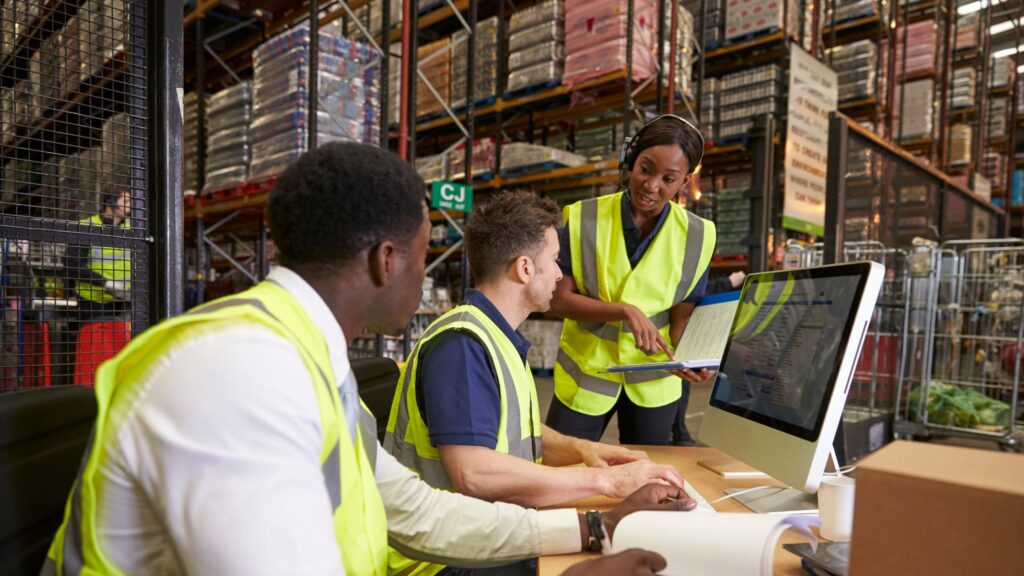At a time when customer satisfaction, profitability and responsiveness are becoming major issues, logistics management is much more than a support function: it’s a real driver of performance and growth for companies. However, controlling logistics costs and optimizing every link in the chain remain daily challenges, particularly in the face of the rapid evolution of e-commerce, heightened consumer expectations and competitive pressure.
Discover how to turn your logistics management into a strategic advantage in this comprehensive guide, structured around 10 practical tips: methods, tools, organization, digitalization, best practices and feedback.
Understanding logistics management: definition, challenges and key stages

Definition and importance of logistics management
Logistics management covers all the processes involved in planning, organizing, coordinating and controlling the flow of goods, information and sometimes even money, from supplier to end customer. It covers procurement, storage, order preparation, transport, delivery and returns processing.
Efficient logistics make it possible :
- Reduce costs linked to storage, transport, stock-outs or product returns.
- Speed up delivery times and improve customer satisfaction.
- Gain flexibility in the face of unforeseen events and peaks in activity.
- Increase visibility of all operations for better decision-making.
“Plan the steps of logistics management with precision to ensure maximum efficiency.” – The Iziship team
The essential steps in logistics management
Each stage plays a crucial role in the overall management of logistics performance:
Needs analysis and planning
This involves anticipating demand, identifying the volumes to be processed and storage capacities, and drawing up reliable forecasts. For example, an e-commerce company preparing for Black Friday needs to forecast its storage, transport, packaging and labor requirements to avoid shortages and delays.
Supplier selection and procurement management
The reliability of the supply chain largely depends on the choice of suppliers: product quality, on-time delivery, capacity to absorb variable volumes, transparency on the origin of raw materials…
Storage and space optimization
A well-organized warehouse, using solutions such as dynamic racking, vertical storage or cross-docking, saves space and speeds up order picking.
Inventory management and automation
The use of automated systems (WMS, real-time inventory, picking robots) minimizes the risk of error, and enables inventory to be adjusted according to sales and seasonality.
Transport, mode choice and route management
Logistics costs soar if transport is poorly optimized. The choice between road, sea, air or rail transport depends on the type of product, the lead times required and the budget.
Distribution and final delivery
Organizing delivery (home, point relais, consignee) and communicating effectively with the end customer limits disputes and promotes customer loyalty.
Returns management
In e-commerce, product returns are no longer the exception, but the rule. A clear returns policy and rapid management of returned products improve confidence and limit losses.
Performance monitoring (KPIs, ongoing analysis)
Tracking key indicators such as inventory turnover, cost per order or service rate enables you to identify levers for improvement and continuously monitor performance.
10 practical tips to optimize and reduce your logistics costs
1. Analyze and optimize your distribution network
A well thought-out distribution network is essential to limit distances traveled, cut transport costs and reduce carbon footprints.
Fact : Major retailers such as Amazon and Decathlon have multiplied their regional hubs to bring stocks closer to areas of high demand, speed up deliveries and reduce mileage costs.
Tip: Use geographic analysis tools (GIS, route optimization) to rethink the layout of your warehouses and distribution centers according to your target customers.
2. Consolidate your shipments to reduce transport costs
Shipping several small packages separately is much more expensive than consolidating them into one or more larger lots.
This makes it possible to :
- Fill trucks to capacity and benefit from better rates from carriers.
- Reduce delivery frequency and therefore unit costs.
- Reduce environmental impact (fewer empty runs).
TipSchedule your shipments to group orders destined for the same geographical area or customer.
3. Automate inventory management with a WMS
A WMS (Warehouse Management System) allows you to :
- Monitor inventory in real time and avoid stock-outs.
- Optimize storage space with intelligent placement algorithms.
- Automate inventory and product location management.
- Efficiently manage order preparation, picking and replenishment.
Fact: an SME that has integrated a WMS can cut order preparation time by 30% and halve shipping errors.
TipChoose a WMS that’s scalable and adapted to the size of your company: there are cloud solutions that are accessible even to small structures.
4. Select reliable and responsible suppliers and carriers
Logistics quality depends on your partners.
- Choose local suppliers whenever possible: shorter lead times, fewer risks, lower transport costs.
Demand traceability of raw materials and environmentally-friendly manufacturing methods. - On the transport side, opt for partners offering real-time tracking services, emergency solutions in the event of delays, and the ability to absorb peaks in activity.
Tiprenegotiate terms with your partners on a regular basis to adapt rates to your growing volume and take advantage of logistical innovations.
5. Evaluate your logistics providers on a regular basis
Your logistics provider of yesterday may no longer be the most competitive today.
- Regularly compare market offerings: new players, innovative technologies, customized solutions.
Measure service quality using KPIs (dispute rates, deadlines met, average costs). - Negotiate open-ended contracts, with price review clauses or performance bonuses/malus.
TipOrganize an annual review of your logistics contracts, and put at least two service providers per service family out to tender.
6. Adopt sustainable logistics practices
Responsible practices not only limit your carbon footprint, but also save you money in the medium term.
- Reduce energy consumption (LED lighting, clean vehicle fleet).
- Choose recyclable or compostable packaging.
- Reduce empty transport by optimizing routes and grouping orders.
Set up a system for recycling or reusing packaging.
Fact : Many e-tailers are integrating water-based inks, eliminating single-use plastic or offering minimalist packaging options.
7. Optimize order picking and packaging

- Pickingmethods: Adopt the method best suited to your volume: picking by order, wave picking, zone picking. The more optimized the method, the fewer unnecessary round trips in the warehouse.
- Choice of packaging: Use tailor-made packaging that protects products while limiting vacuum (and therefore transport costs). Smart packaging means less breakage, fewer returns, and a better customer experience.
- Personalization and branding: Eco-designed packaging in brand colors can also boost loyalty.
Fact: An e-tailer using pick-to-light reduces preparation errors by 40%.
8. Offer several delivery options and track shipments in real time
- Offer a choice of home delivery, relay point or automatic consignment. Every customer has his or her own preferences.
- Real-time tracking of shipments via SMS, e-mail or mobile app builds confidence and helps anticipate delivery problems.
- Transparency about lead times and order progress is a key factor in customer satisfaction.
Tip: Connect your logistics system to your e-commerce site so that the customer is informed at every stage, from shipping to receiving.
9. Manage returns
- Display a clear , easy-to-read returns policy: this reassures customers and makes it easier for them to make a purchase.
- Offer prepaid return labels or collection points to simplify the process.
- Automate returns management (reception, inspection, return to stock, refund) to limit costs and speed up refunds.
- Analyze the reasons for returns to improve your products or your online description.
10. Use data analysis to drive logistics optimization
Today, data is a central lever for cost optimization and continuous improvement.
- Track logistics KPIs: inventory turnover rate, breakage rate, preparation cost per order, average delivery time, returns rate, delivery cost, customer satisfaction rate, etc.
- Use predictive analysis to anticipate demand peaks, adjust orders and reduce overstock.
- Analyze partner performance and identify bottlenecks.
TipInvest in BI (Business Intelligence) tools or use analysis modules integrated into your ERP/WMS to drive continuous improvement.
Essential technologies for high-performance logistics

Advanced management systems: WMS, TMS, ERP
- WMS (Warehouse Management System): For automated management of stocks, inventories and internal flows.
- TMS (Transport Management System): For planning and optimizing transport routes, tracking deliveries and analyzing costs.
- ERP (Enterprise Resource Planning): To centralize all company data (inventory, purchasing, sales, finance) and facilitate decision-making.
Fact: Integrating a WMS and a TMS with an ERP system enables global management of the supply chain, anticipating out-of-stock situations and automating supplier orders.
Automating and digitizing logistics processes
Automation and digitalization enable :
- Save time on repetitive tasks (preparation, dispatch, invoicing, etc.)
- Reduce human error.
- Facilitate ramp-up during seasonal peaks.
- Centralize information for greater responsiveness.
E-commerce logistics: specificities and best practices
Adapting logistics management to e-commerce
E-commerce imposes unique requirements:
- Ability to absorb sudden peaks in orders (sales, Black Friday, holidays, etc.).
- High expectations for fast shipping and transparent tracking.
Optimized management of returns, which are on average three times more frequent than in physical stores.
Best practices :
- Provide scalability solutions for warehousing and transport.
- Multiply delivery and return options.
Implement proactive communication (email/SMS to customers at every stage).
Focus on customer experience and loyalty
A smooth, fast and seamless logistics experience makes all the difference.
- Fast , reliabledelivery: 60% of shoppers abandon their shopping baskets if delivery times or costs are inconvenient.
- Precise , personalizedtracking: receiving an SMS alert at every stage of the process reassures customers.
- Easy returns: A simple product return promotes reassurance and loyalty.
TipRegularly analyze customer feedback on shipping/delivery and quickly correct any reported irritants.
In a nutshell
Logistics management is a strategic pillar of profitability and customer satisfaction. By implementing these 10 tips, relying on automation, data analysis and reliable partners, you have all the levers you need to transform your logistics into a sustainable competitive advantage.




